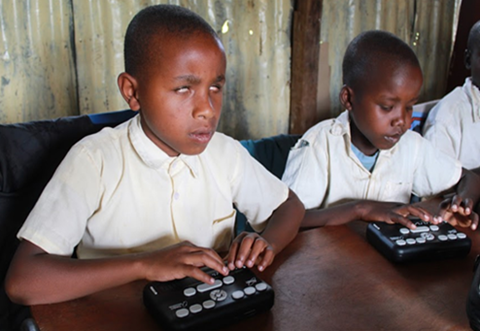Case Study: Enabling Access to Quality, Inclusive Education for Learners with Visual Impairment in Africa
KBTA’s Commitment:
Kilimanjaro Blind Trust Africa (KBTA) a charitable trust based in Nairobi, Kenya works in 5 countries of East Africa and Malawi to promote inclusion of learners with visual impairments (VI) by providing digital, multifunctional Braille assistive devices with full-service support to ensure that every VI learner has a functioning device. The Orbit Reader 20 is a Braille note-taker and book reader accompanied by mobile applications that have enabled VI learners in Africa to access quality education in inclusive schools. KBTA’s ambitious target is to distribute 3000 devices across the 5 countries.
Innovation of the ORBIT Project:
In Africa poverty is linked to disability. There is no inclusion without access to quality education. The VI learners in Africa are passive learners in the classroom without appropriate assistive devices. The public institutions are cash strapped and cannot provide the technology needed for access to digital literacy/skills or even STEM subjects that can give them career choices and access to relevant employment.
KBTA sought out affordable digital Braille technology in 2018 from US innovators called the Orbit Reader 20 (OR20). Their innovative strategy worked to cover entire class cohorts across all the schools, in order to ensure uniformity. Working with governments and their agencies, KBTA delivered the OR20 to learners across approximately 100 schools and 1000 plus learners in inclusive classrooms across 5 countries, starting the process in primary followed by secondary schools and finally institutions of higher learning such as Universities, TVET institutions and Teacher Training colleges.
KBTA also ensured that the OR20 were:
- loaded with the digital Braille curriculum content and other reading material;
- the teachers in each institution were trained while working with the school management to ensure proper use and security of the Orbit Readers;
- KBTA also trained school-based technicians, a concept developed internally to support continuity of use;
- providing spare parts;
- continuously supporting the schools to adequately support the VI learners; and
- KBTA has been able to enhance access to digital literacy/skills for VI learners, in order to take the next step towards career selection, employability skills and employment.
The Impact on VI Learners and Progressing Towards Employability:
The OR20 has literally transformed access to education for the VI learners in 5 African countries. It has changed the way teachers in overcrowded, inclusive classrooms are able to support the VI learner. The learners are able to participate easily in classroom assessments and tests, take notes and get responses to their queries from teachers by using the mobile applications, which also support those with hearing impairments. The VI learner has improved reading skills through access to story books and other learning material of interest. The VI teachers are able to prepare for and teach their classes without having to depend on transcribers. KBTA is now working to provide access to STEM subjects and computer sciences which the learners were unable to access. Progress is thus rapidly taking place due to digital technology/innovation towards access to varied employment skills and opportunities. The OR20 has brought down the cost of educating the VI learner.
The first cohort of learners who started with the Orbit Reader in 2019 took their primary/secondary national examinations in 2021 and registered exemplary performance compared to the previous years.


Figure 5.4: Visually impaired learners using the orbit reader (left) and a birds-eye view of orbit reader (right).
This case study was excerpted from Disability Interactions: Creating Inclusive Innovations by Catherine Holloway and Giulia Barbareschi, https://doi.org/10.1007/978-3-031-03759-7, pages 109–111.